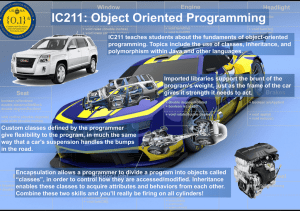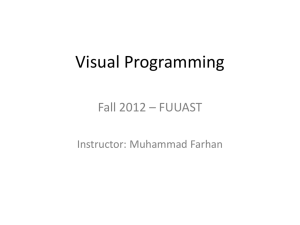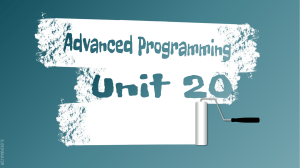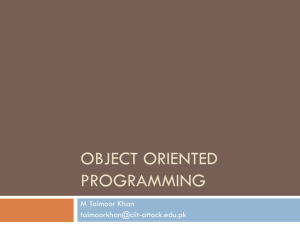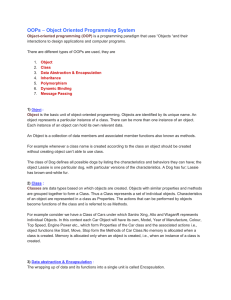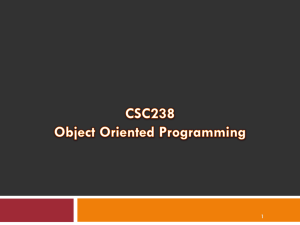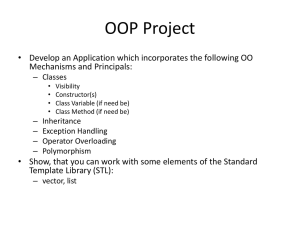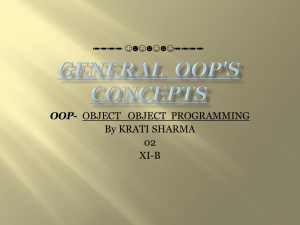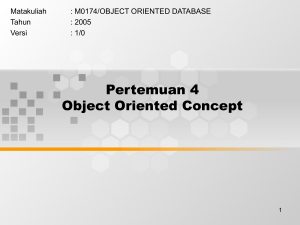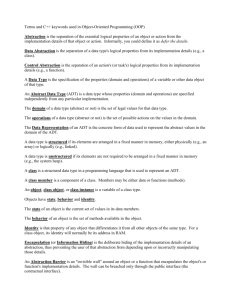5 General OOP Concepts
advertisement
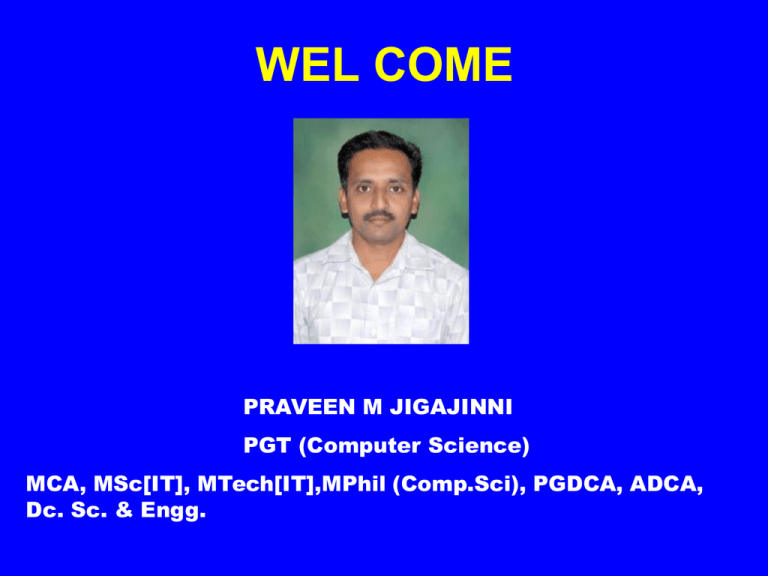
WEL COME
PRAVEEN M JIGAJINNI
PGT (Computer Science)
MCA, MSc[IT], MTech[IT],MPhil (Comp.Sci), PGDCA, ADCA,
Dc. Sc. & Engg.
Reference Book
CLASS XI
By
Sumita Arora
CHAPTER 5
GENERAL OOP
CONCEPTS
EVOLUTION OF
SOFTWARE
A PROGRAMMING LANGUAGE SHOULD SERVE
2 RELATED PURPOSES :
1. It should provide a vehicle for
programmer to specify actions to be
executed.
2. It should provide a set of concepts for the
programmer to use when thinking about
what can be done.
A PROGRAMMING LANGUAGE SHOULD SERVE
2 RELATED PURPOSES :
1. The first aspect ideally requires a
language that is “close to the machine”.
2. The second aspect ideally requires a
language that is “close to the problem to
be solved”
LOW LEVEL LANGUAGES
ARE MACHINE ORIENTED
Require Extensive Knowledge of
computer circuitry
Ex : Machine language & Assembly
language
Serve only 1st aspect “close to
machine”
LOW LEVEL LANGUAGES
Machine Language :: instructions are written
in binary code in it . Only language that
computer can execute directly.
Assembly Language :: instructions r written
using symbolic names for machine operation
{READ,ADD,STORE} & operands. Program
is then converted into machine language
using ASSEMBLER software.
HIGH LEVEL LANGUAGE
OFFER English like keywords, constructs for
sequence, selection & looping and use of
variables & constants.
Its programs r converted into machine language
using compiler or interpreter
Serve only 2nd aspect “close to programmer”
Languages like C & C++ serve
both the aspects
and hence, can be called as
Middle Level Languages
PROGRAMMING PARADIGMS
PARADIGM means organizing principle
of a program . It is an approach to the
programming.
Ex : Procedural programming
Modular programming
Object oriented programming
PROCEDURAL PROGRAMMING
The focus is on processing
It says :
DECIDE WHICH PROCEDURES YOU WANT
USE THE BEST ALGORITHMS YOU CAN FIND
Languages support it by providing facilities
for passing arguments to functions &
returning values from functions
MODULAR PROGRAMMING
A SET OF RELATED PROCEDURE WITH DATA
THEY MANIPULATE IS CALLED A MODULE.
It says
DECIDE WHICH MODULES YOU WANT
PARTITION THE PROGRAM
SO THAT DATA IS HIDDEN IN MODULES
Works on principle of grouping
components that carry out specific tasks.
of
Drawbacks of Procedural &
Modular Approaches
• They do not model real world well. like a
procedural program on library management
aims at operations like issued, returned & give
2nd class status to real world entities : books.
• In modular programming, since many modules
access same data, arrangement of data can’t be
changed without modifying all modules that
access it
OBJECT ORIENTED
PROGRAMMING
OBJECT ORIENTED PROGRAMMING
OBJECT is an identifiable entity with some
characteristics and behavior.
In OOP programming object represents a
entity that can store data and has its
interface through functions.
CLASS is a template/blue-print representing
a group of objects that share common
properties and relationships.
It says:
decide which classes and objects are needed
provide a full set of operations for each class
OBJECT 1
PROPERTIES
BEHAVIOUR
OBJECT 2
PROPERTIES
BEHAVIOUR
DATA & FUNCTIONS ENCLOSED WITHIN OBJECTS
NEW OBJECTS COMMUNICATE WITH EACH OTHER
PROCEDURAL PARADIGM
FUNCTION 1
DATA 1
FUNCTION 2
DATA 2
FUNCTION 3
GENERAL CONCEPTS OF OOP
1. DATA ABSTRACTION
2. DATA ENCAPSULATION
3.MODULARITY
4. INHERITANCE
5.POLYMORPHISM
DATA ABSTRACTION
ABSTRACTION refers to the act of
representing essential features without
including the background details or
explanations.
It focuses upon the observable behavior of
an object.
ENCAPSULATION
The wrapping up of data and operations /
functions (that operate on the data ) into a
single unit (called class) is known as
ENCAPSULATION.
Encapsulation is a way to implement data
abstraction. It hides the details of the
implementation of an object.
It focuses upon the implementation that gives
rise to observable behavior.
DATA
MEMBER
FUNCTIONS
DATA
DATA
MEMBER
FUNCTIONS
MEMBER
FUNCTIONS
THE OOP APPROACH
DATA ABSTRACTION & ENCAPSULATION
MODULARITY
It is the property of a system that has
been decomposed into a set of
cohesive and loosely coupled modules.
It reduces complexity of program
It Creates a number of well-defined,
documented boundaries within the
program.
Inheritance is the capability of one
class of things to inherit capabilities or
properties
from
other
class.
UP NEXT
Why inheritance was introduced into
OO languages ?
INHERITANCE
1.
2.
3.
+
POINTS
Capability to express the inheritance relationship
which makes it ensure closeness with real world
models.
Idea of reusability. It allows addition of additional
features to an existing class without modifying it. A
subclass defines only those features which are
unique to it.
If a class A inherits properties of another class B,
then all subclasses of A will automatically inherit
the properties of B. This is called
transitive nature of inheritance.
POLYMORPHISM
It is the ability for a message or data to be
processed in more than one form.
It is a property by which the same message
can be sent to objects of several different
classes, & each object can respond in a
different way depending on its class.
Languages that support classes but not
polymorphism are called OBJECT BASED
languages.
ADVANTAGES OF OOPs
1. It models real world well.
2. Programs are easy to understand.
3. It offers class reusability. Already
created classes can be reused without
having to write them again.
4. It facilitates quick development as
parallel development of classes is
possible.
5. Programs are easier to test, manage
& maintain.
DIS-ADVANTAGES OF OOPs
1.
Classes tend to be overly generalized.
2.
The Relations Among Classes Becomes Artificial At
Times.
3.
OOP Programs Design Is Tricky.
4.
One needs to do proper planning & proper design
for OOP programming.
5.
To program with OOPs, programmer needs proper
skills such as design skills, programming skills,
thinking
in terns of objects etc.
THANK
YOU
